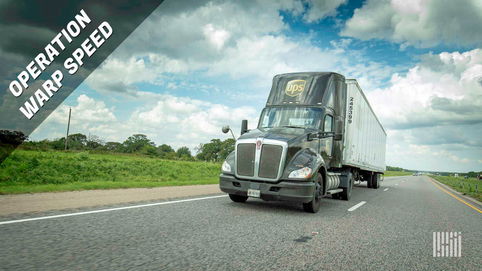The biggest and most important civilian logistics project in American history is under way, and trucks are likely to be at the center of it.
Trucks operated by UPS Inc. (NYSE:UPS) and FedEx Express, the air express unit of FedEx Corp. (NYSE:FDX) hit the road Saturday to begin distributing hundreds of millions of COVID-19 vaccine shipments designed to end the scourge that has claimed more than 290,000 American lives, just hours after the Food and Drug Administration authorized the emergency use of a vaccine from U.S. drug giant Pfizer Inc. (NYSE:PFE) and its German partner BioNTech.
Meanwhile, Defense Department officials say they expect to receive their first allotment of vaccines, about 44,000 doses, as early as next week. Unitrans International Corp., a life sciences distribution provider and wholly owned unit of Chicago-based AIT Worldwide Logistics, expects to be involved in surface deliveries of the vaccine from distribution centers to U.S. military installations domestically and around the world, Unitrans President Andrew Schadegg said in an interview late Friday.
The Pfizer vaccine, which must be kept at -70 degrees Celsius or colder, is being packed in dry ice for distribution. Because of the ice, the packaging itself acts as the cooling agent and mitigates the need for refrigerated equipment to maintain the necessary temperatures.
Conventional refrigerated trailers, which are effective at temperatures as low as -20 C., would have a very hard time achieving the super-cold levels that the Pfizer vaccine requires, according to Schadegg. A vaccine from U.S. biotechnology company Moderna (NASDAQ:MRNA), whose emergency use authorization request will be the subject of a Dec. 17 FDA meeting, can be kept at -20.
It is expected that truckers involved in the vaccine distribution will work in teams so one driver can remain with the vehicle at all times, Schadegg said. Approved drivers will be thoroughly vetted for security purposes and will be expected to have prior experience handling specialized pharmaceutical shipments, he added.
The life sciences supply chain is not reinventing the wheel, Schadegg said. It is familiar with the complex distribution protocols because it’s been through them many times before, he said. “The logistics and understanding of how this is supposed to work is already in place,” he said.
The difference with the Pfizer vaccine, and those that may immediately follow, is the rapid upscaling, coping with winter weather issues in many parts of the country, and competing for precious trailer space with an unprecedented peak-season shipping cycle, Schadegg said.

“There’s no redundant capacity waiting for work out there. Everything is pretty full,” he said.
Not every vaccine shipment will find its way into an American’s arm. A vaccine like Pfizer’s with such extreme handling requirements cannot fall out of its required temperature range for very long. In addition, even the smallest fracture from a dropped shipment or a jostled pallet would declare some vaccine vials unusable by cautious practitioners, Schadegg added.
Vaccines are not considered as high value as other pharmaceutical products because they are mass-produced and manufacturers don’t incur massive product marketing costs that must be recouped by producers of drugs that treat disorders like rheumatoid arthritis (RA). For example, an annual flu shot may cost a consumer, at most, $25 out of pocket. Because the 2020-21 flu season coincides with the still-raging novel coronavirus, some providers are dispensing traditional flu vaccines for free. By contrast, a name-brand drug to treat RA could retail for many times that.
However, COVID-19 vaccines may not follow the script because they are in demand by billions of people, and there is an acute sense of urgency in getting access to them, Schadegg said.
The initial step will be to distribute about 3 million doses within the first week to health care workers and nursing home residents. Vaccines should begin arriving on Monday at dispensing locations in parts of the U.S.
Pfizer has committed to developing 100 million doses by the end of March. To achieve full protection, each vaccinated individual will require two doses about three to three to four apart.
